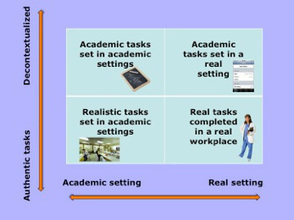Finding it difficult to learn math? If yes, then here are the best ever tips on how to learn math from basic to the advanced level. Follow all these tips to st…
Get Started for FREE
Sign up with Facebook Sign up with X
I don't have a Facebook or a X account
 Your new post is loading... Your new post is loading...
 Your new post is loading... Your new post is loading...

Gust MEES's curator insight,
March 22, 2015 11:26 AM
This is a follow up to a post I wrote, How Do We Learn? How Should We Learn? The purpose of these posts is to encourage educators to examine practices they take for granted, implement without deep... The following are some suggestions for establishing context (the list is just a start). Ironically, they are practices that are often recommended are best practices in teaching but they aren’t implement as often as they should be:

James J. Goldsmith's curator insight,
March 23, 2015 9:02 AM
Makes a strong argument for the importance of context in learning and provides useful links with more information about and to support this point of view. |

Gust MEES's curator insight,
December 28, 2016 2:51 PM
Mastery learning is the idea that students should adequately comprehend a given concept before being expected to understand a more advanced one. This idea has a long tradition in educational theory and research. In 1919, superintendent Carleton W. Washburne in Winnetka, Illinois, showed that students could advance at their own pace if they mastered a concept before moving on to something more complicated.
Years later, building on Washburne’s work, educational psychologist Benjamin Bloom coined the term “mastery learning.” In 1984, in Bloom’s seminal study, “The 2 Sigma Problem,” he showed that mastery-based one-on-one tutoring is two standard deviations more effective than conventional instruction. (That means it would take the average for a cohort of students from the 50th percentile to the 98th percentile!). Ever since, educators have sought ways to make mastery learning available to all students.
Learn more / En savoir plus / Mehr erfahren:
http://www.scoop.it/t/21st-century-learning-and-teaching/?tag=modern-education
http://www.scoop.it/t/21st-century-learning-and-teaching/?tag=Learning+by+doing
http://www.scoop.it/t/21st-century-learning-and-teaching/?tag=Practice
Vidyanext's comment,
January 6, 2017 2:11 AM
Students master in learning with advanced learning model. Vidyanext Learning Model combines expert tutors with technology for better teaching that helps student succeed with better marks and also set a strong academic foundation. Read here about Vidyanext learning Model, https://www.vidyanext.com/learning-model/

Gust MEES's curator insight,
March 22, 2015 11:26 AM
This is a follow up to a post I wrote, How Do We Learn? How Should We Learn? The purpose of these posts is to encourage educators to examine practices they take for granted, implement without deep... The following are some suggestions for establishing context (the list is just a start). Ironically, they are practices that are often recommended are best practices in teaching but they aren’t implement as often as they should be:

James J. Goldsmith's curator insight,
March 23, 2015 9:02 AM
Makes a strong argument for the importance of context in learning and provides useful links with more information about and to support this point of view. |











